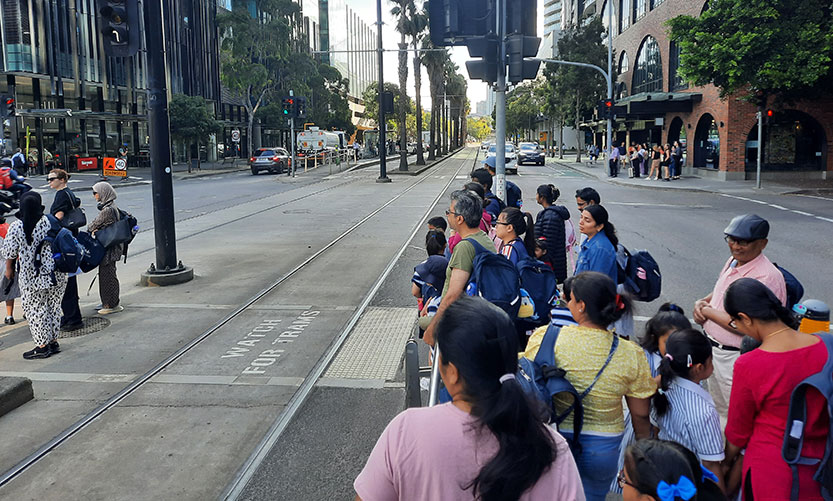Tram stops for pedestrians?
Trams provide space-efficient low-carbon transport in cities around the globe, connecting walkable neighbourhoods within metropolitan areas.
Melbourne has the longest tram network in the world, with routes connecting Docklands to the inner city and further.
It also has one of the slowest services at an average speed of only 16km/h, less than most cyclists can do. In contrast, better designed tram networks achieve average speeds of around 30km/h, without increased risk to safety.
Much of this has to do with tram stop design. Frequent stops, narrow doors, and steps to negotiate, slow trams down. At times there is gentle social friction in tram doorways, at other times it is excruciating overcrowding. If is easy to embark and disembark, then network speed increases, and overcrowding can be reduced. Level access reduces idle time at stops considerably. Hence the new generation of low-floor trams combined with slightly elevated tram stop platforms.
But there is a hiccup. For “safety” considerations, these “super stops” that are providing level-access, like in Docklands, are surrounded by fences. Some are up to 80 metres long and are doubled-up at the entries. That makes pedestrian access difficult, often squeezing dozens of people in most uncomfortable ways, pushed into each other’s personal spaces. Watch the video.

It seems that the transport engineers have forgotten that tram riders walk to and from the tram stop. The concern to improve access between tram stop platforms and trams seems to have obscured the imperative need to walk into and out of stops. Fences make some of the stops look more like a fortress against vandals, than a civic space for people to enjoy life and socialise.
This is all very abstract, many will think, so let’s take a specific example. Stop D2 named “Central Pier” with its northern access aligned with the eastern end of New Quay Promenade, is linking many residents to their workplaces in the CBD and beyond. Fences that are 75 metres long make people scramble during the short green-light cycle. Most will cross on red as car traffic is restricted to one lane and comes in easily legible packs.
In a highly formalised city, most of us feel uneasy to behave informally. Yet informal crossing is a most logical thing to do: to shorten waiting time, walking distance, or evade unpleasant overcrowding. It has also been long argued that we have a right to do so, from the Chicago school of urban sociology to Churchill and many more.
If the ways cities are designed change us, and we have a right for self-determination, then we have a “right to the city” – to have a say about how we use and shape the city we live in.
When Docklands was redeveloped from industrial land to a mixed-use neighbourhood, there weren’t many residents to consult. Yet by now this area has evolved into an increasingly diverse and dense neighbourhood where residents start asserting their rights.
Tram stops could be designed as shared zones, with low speed-limits, pedestrians having a right of crossing at all times. Crossing could be safer, tram access easier, network speed faster and people happier. Gradually even more people would choose to walk, which is good for individual health and the global environment.
Barriers to this are our counter-intuitive fears. We tend to think that fences always protect us. Even when they distract from how we cross the street, by providing false symbolic reassurance. Even when they induce increased vehicle speeds – the main cause of collisions and fatalities. Even when we are constrained by fences on the inside or excluded on the outside. Maybe, with less fences and more shared spaces, we may have more freedom of movement and chances of encounter.
Dr Elek Pafka is a senior lecturer in urban planning and urban design at the Faculty of Architecture, Building and Planning at the University of Melbourne. •

New park to revitalise historic maritime precinct in Docklands







 Download the Latest Edition
Download the Latest Edition